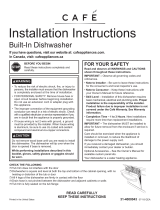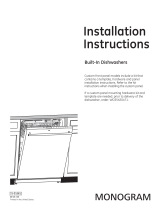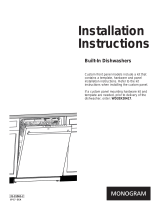
Installation Instructions
Built-In Dishwasher
If you have questions, call GE Appliances at 800.GE.CARES (800.432.2737) or visit our website
at: GEAppliances.com. In Canada, please call 1.800.561.3344 or visit www.geappliances.ca
READ CAREFULLY
KEEP THESE INSTRUCTIONS
FOR YOUR SAFETY
Read and observe all WARNINGS and CAUTIONS
shown throughout these instructions.
While performing installations described in this booklet,
gloves, safety glasses or goggles should be worn.
IMPORTANT – Observe all governing codes and
ordinances.
• Note to Installer – Be sure to leave these instructions for
the consumer’s and local inspector’s use.
• Note to Consumer – Keep these instructions with your
Owner’s Manual for future reference.
• Skill Level – Installation of this dishwasher requires
basic mechanical, electrical and plumbing skills. Proper
installation is the responsibility of the installer. Product
failure due to improper installation is not covered under
the GE Appliances Warranty. See warranty information.
• Completion Time – 1 to 3 Hours. New installations
require more time than replacement installations.
IMPORTANT – The dishwasher MUST be installed to
allow
for future removal from the enclosure if service is required.
Care should be exercised when the appliance is installed or
removed,
to reduce the likelihood of damage to the power
supply cord.
If you received a damaged dishwasher, you should
immediately contact your dealer or builder.
Optional Accessories – See the Owner’s Manual for
available custom panel kits.
Your dishwasher is a water heating appliance.
BEFORE YOU BEGIN
Read these instructions completely and
carefully.
31-31560-1 09-16 GEA
• To reduce the risk of electric shock, fire, or injury to
persons, the installer must ensure that the dishwasher
is completely enclosed at the time of installation.
• FOR PERSONAL SAFETY: Remove house fuse or open
circuit breaker before beginning installation. Do not use
an extension cord or adapter plug with this appliance.
• The improper connection of the equipment grounding
conductor can result in a risk of electric shock. Check
with a qualified electrician or service representative if
you are in doubt that the appliance is properly grounded.
• If house wiring is not 2-wire with ground, a ground
must be provided by the installer. When house wiring
is aluminum, be sure to use UL-Listed anti-oxidant
compound and aluminum-to-copper connectors.
Do not remove wood base until you are ready to install
the dishwasher. The dishwasher will tip over when the
door is opened if base is removed.
CHECK THE FOLLOWING
Tub trim does not interfere with the door
Dishwasher is square and level at both the top and
bottom of the cabinet opening, with no twisting or
distortion of the tub or door
All 4 legs of the dishwasher are firmly in contact with the
floor
Drain hose is not pinched between the dishwasher and
adjacent cabinets or walls
Tub trim is fully seated on the tub flange
WARNING
CAUTION


















